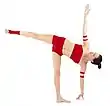Balasana
Bālāsana (Sanskrit: बालासन), Child's Pose,[1] or Child's Resting Pose is a kneeling asana in modern yoga as exercise. Balasana is a counter asana for various asanas and is usually practiced before and after Sirsasana.[2]

Etymology and origins
The name comes from the Sanskrit words बाल bala, "child" and आसन asana, "posture" or "seat".[3]
Balasana is not described until the 20th century; a similar pose appears in Niels Bukh's 1924 Primary Gymnastics.[4][5]
Ananda Balasana is illustrated as Kandukasana (Ball Pose) in the 19th century Sritattvanidhi.[6]
Description
From a kneeling position, bring the forehead to the floor and relax the arms alongside the body, palms upwards.[7]
Variations

If need be, and during pregnancy, the knees can be spread.[7] The arms may be stretched forward in front of the head.[8]
Discomfort in the neck and shoulders while performing Child's Pose can be alleviated "by placing a thickly rolled blanket between your buttocks and heels, then bend your elbows and stack your forearms so you can rest your forehead on them."[9]
Ananda Balasana or "Happy Baby Pose" is an inverted form of Child's Pose; it has the body on the back, the thighs alongside the body, the knees bent and the hands grasping the toes.[10]
Uttana Shishosana or "Extended Puppy Pose" stretches forwards from all fours until the forearms and forehead are resting on the floor and the thighs are vertical, giving a pose intermediate between Balasana and Adho Mukha Shvanasana (Downward Dog Pose).[11]
Shasangasana (शसांगासना) or "Rabbit Pose", practised in Bikram Yoga, has the tailbone lifted until the thighs are vertical and the head and arms pointing back towards the feet, creating an intense flexion of the spine.[12]
See also
References
- "Child's Pose". Yoga Journal. Archived from the original on 11 May 2011. Retrieved 9 April 2011.
- "4 Counter Poses to Do Before and After Headstand". Virginia is for Yoga Lovers. Archived from the original on 27 November 2016. Retrieved 27 November 2016.
- Sinha, S. C. (1996). Dictionary of Philosophy. Anmol Publications. p. 18. ISBN 978-81-7041-293-9.
- Singleton, Mark (2010). Yoga body : the origins of modern posture practice. Oxford University Press. p. 200. ISBN 978-0-19-539534-1. OCLC 318191988.
- Bukh, Niels (2010) [1924]. Primary Gymnastics. Tufts Press. p. 32. ISBN 978-1446527351.
- Sjoman, Norman E. (1999) [1996]. The Yoga Tradition of the Mysore Palace (2nd ed.). Abhinav Publications. pp. 15, 70, plate 1 (pose 6). ISBN 81-7017-389-2.
- Lidell, Lucy; The Sivananda Yoga Centre (1983). The book of yoga. Ebury. pp. 37, 161. ISBN 978-0-85223-297-2. OCLC 12457963.
- YJ Editors (28 August 2007). "Child's Pose". Yoga Journal. Retrieved 10 February 2019.
- Kathryn Ashworth. "3 Variations to Try When Child's Pose Doesn't Feel Like a Resting Pose". Yoga International. Retrieved 17 March 2019.
- Newell, Zo. "The Mythology Behind Ananda Balasana (Happy Baby Pose)". Yoga International. Retrieved 8 February 2019.
- YJ Editors (28 August 2007). "Extended Puppy Pose". Yoga Journal. Retrieved 10 February 2019.
- "Learn Sasangasana (Rabbit Pose)". Yoga International. Retrieved 23 April 2019.
External links
- Yoga Journal Photo and instructions
_from_Jogapradipika_1830_(detail).jpg.webp)
